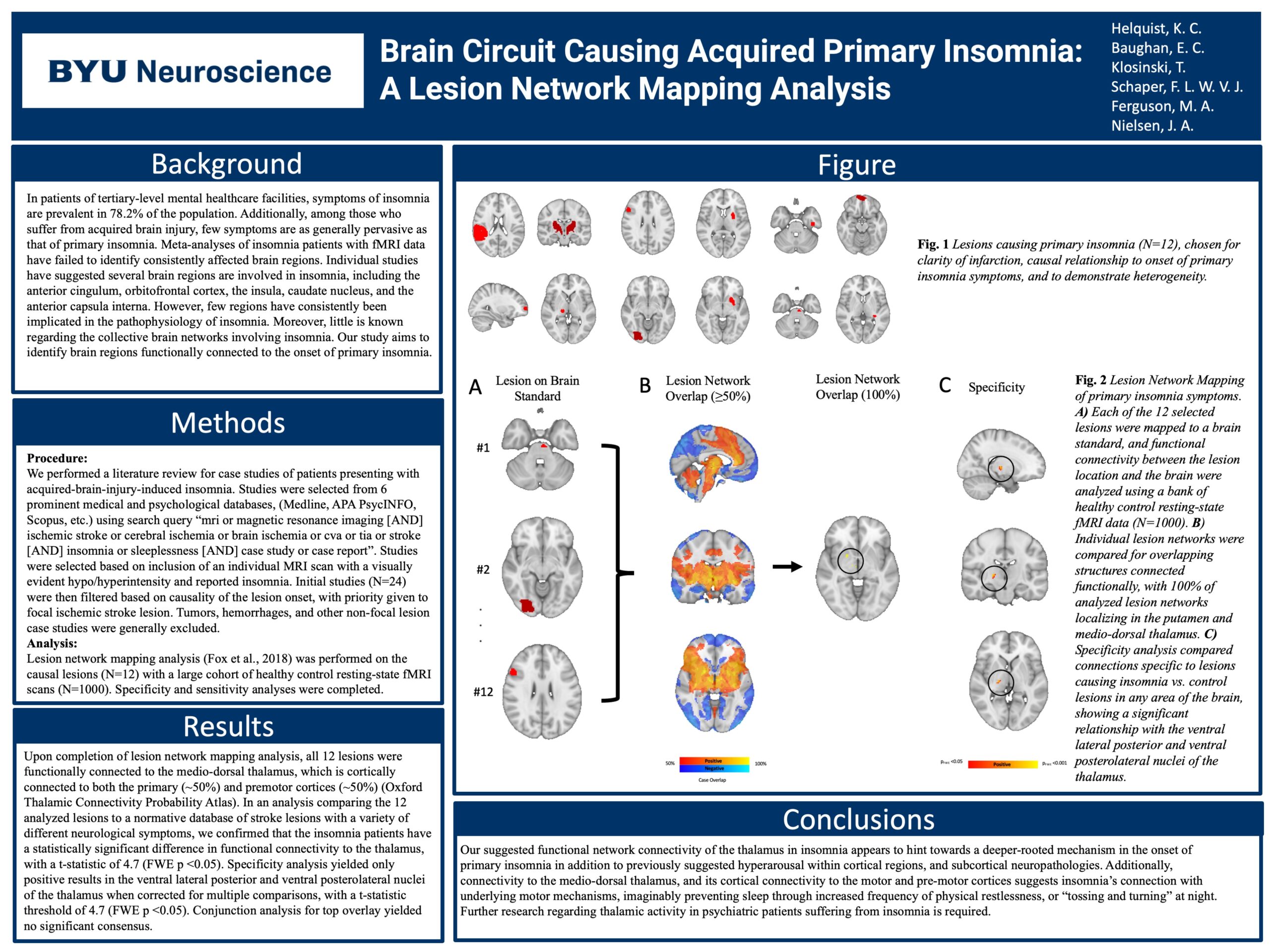Presenter Name: Keaton Helquist
Description
BACKGROUND
In patients of a tertiary-level mental healthcare facilities, symptoms of insomnia are prevalent in 78.2% of the population. Additionally, among those who suffer from acquired brain injury, few symptoms are as generally pervasive as that of primary insomnia. Meta-analyses of insomnia patients with fMRI data have failed to identify consistently affected brain regions. Individual studies have suggested several brain regions are involved in insomnia, including the anterior cingulum, orbitofrontal cortex, the insula, caudate nucleus, and the anterior capsula interna. However, few regions have consistently been implicated in the pathophysiology of insomnia. Moreover, little is known regarding the collective brain networks involving insomnia. METHODS
We performed a literature review for case studies of patients presenting with acquired-brain-injury-induced insomnia (N=12). Lesion network mapping analysis (Fox et al., 2018) was performed on the 12 lesions with a large cohort of healthy control resting-state scans (N=1000). RESULTS
Upon completion of lesion network mapping analysis, all 12 lesions were functionally connected to the medio-dorsal thalamus, which is cortically connected to both the primary (~50%) and premotor cortices (~50%) (Oxford Thalamic Connectivity Probability Atlas). In an analysis comparing the 12 analyzed lesions to a normative database of stroke lesions with a variety of different neurological symptoms, we confirmed that the insomnia patients have a statistically significant difference in functional connectivity to the thalamus. CONCLUSION
Our suggested functional network connectivity of the thalamus in insomnia appears to hint towards a deeper-rooted mechanism in the onset of primary insomnia in addition to previously suggested hyperarousal within cortical regions, and subcortical neuropathologies. Further research regarding thalamic activity in psychiatric patients suffering from insomnia is required.
In patients of a tertiary-level mental healthcare facilities, symptoms of insomnia are prevalent in 78.2% of the population. Additionally, among those who suffer from acquired brain injury, few symptoms are as generally pervasive as that of primary insomnia. Meta-analyses of insomnia patients with fMRI data have failed to identify consistently affected brain regions. Individual studies have suggested several brain regions are involved in insomnia, including the anterior cingulum, orbitofrontal cortex, the insula, caudate nucleus, and the anterior capsula interna. However, few regions have consistently been implicated in the pathophysiology of insomnia. Moreover, little is known regarding the collective brain networks involving insomnia. METHODS
We performed a literature review for case studies of patients presenting with acquired-brain-injury-induced insomnia (N=12). Lesion network mapping analysis (Fox et al., 2018) was performed on the 12 lesions with a large cohort of healthy control resting-state scans (N=1000). RESULTS
Upon completion of lesion network mapping analysis, all 12 lesions were functionally connected to the medio-dorsal thalamus, which is cortically connected to both the primary (~50%) and premotor cortices (~50%) (Oxford Thalamic Connectivity Probability Atlas). In an analysis comparing the 12 analyzed lesions to a normative database of stroke lesions with a variety of different neurological symptoms, we confirmed that the insomnia patients have a statistically significant difference in functional connectivity to the thalamus. CONCLUSION
Our suggested functional network connectivity of the thalamus in insomnia appears to hint towards a deeper-rooted mechanism in the onset of primary insomnia in addition to previously suggested hyperarousal within cortical regions, and subcortical neuropathologies. Further research regarding thalamic activity in psychiatric patients suffering from insomnia is required.
University / Institution: Brigham Young University
Type: Poster
Format: In Person
Presentation #D34
SESSION D (3:30-5:00PM)
Area of Research: Health & Medicine
Email: keaton.helquist@gmail.com
Faculty Mentor: Jared Nielsen

